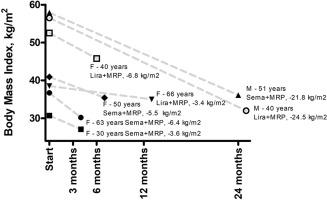Retrospective review of seven patients with obesity simultaneously treated with a combination of a glucagon-like peptide-1 receptor agonist and a meal replacement product
引用次数: 0
Abstract
Background
The use of meal replacement products (MRPs) to obtain a caloric deficit while maintaining micro- and macronutrient requirements, has a long tradition in obesity medicine. Limitations include low compliance, variability in efficacy, adverse events (related to acute changes in nutrient intake), and risk of weight regain when discontinued, and their popularity has declined after the emergence of potent GLP-1 receptor analogues (GLP1-RAs). However, GLP-1RAs have limitations, including dose-dependent risk for adverse events (AEs), high cost, as well as weight regain when discontinued. Although concomitant use of MRPs and GLP-1RAs could address some of the limitations, there is a scarcity of data reported on this. Herein we report real world clinical experience of such combined use.
Methods
This retrospective case evaluation involved people with obesity that concomitantly used MRPs (Optifast) and a GLP-1RA and were followed at one of three weight management centers in Australia or South Africa. Parameters collected were gender, age, co-morbidities, height, weight, frequency/amount of MRPs used, dose/type of GLP-1RA used, duration of combined use, and occurrence of AEs. Written informed consent for use of data was obtained from each individual, and the data were managed in an anonymized form and summarized descriptively.
Result
A total of seven (5 females) individuals (mean [min, max] age 49 [30,66] years, BMI 44.8 [30.7, 57.9] kg/m2) initiated either semaglutide (n=4) or liraglutide (n=3) concomitantly with daily MRPs (starting number of servings/day 2.7 [1,6]) for a duration of 12 [4, 25] months. Change in weight/BMI/% TBW was -32.0 (-9.6, -77.8) kg/-10.3 (-3.4, -24.5) kg/m2/-24.2 %. Five individuals experienced ≥1 GLP-1RA related AE (nausea, reflux, burping, diarrhea, constipation). One individual discontinued GLP-1RA, whereas two persons discontinued the use of MRPs.
Conclusions
MRPs can be initiated concomitantly with a GLP-1 RA for weight management. This might enhance weight-loss effectiveness, with potential additional benefits that should be elucidated in further and larger studies.

对同时接受胰高血糖素样肽-1 受体激动剂和代餐产品联合治疗的七名肥胖症患者的回顾性研究
背景在肥胖症医学中,使用代餐产品(MRPs)来获得热量赤字,同时维持微量和宏量营养素需求的传统由来已久。其局限性包括依从性低、疗效不稳定、不良事件(与营养摄入量的急性变化有关)以及停用后体重反弹的风险,在强效 GLP-1 受体类似物(GLP1-RA)出现后,其受欢迎程度有所下降。然而,GLP-1RAs 也有其局限性,包括不良事件(AEs)风险与剂量有关、成本高以及停药后体重反弹等。虽然同时使用 MRPs 和 GLP-1RAs 可以解决部分局限性,但这方面的数据报告却很少。方法这项回顾性病例评估涉及同时使用 MRPs(Optifast)和 GLP-1RA 的肥胖症患者,他们在澳大利亚或南非的三家体重管理中心之一接受了随访。收集的参数包括性别、年龄、合并疾病、身高、体重、使用 MRPs 的频率/数量、使用 GLP-1RA 的剂量/类型、合并使用的持续时间以及发生的 AEs。结果共有 7 人(5 名女性)(平均[最小,最大]年龄 49 [30,66] 岁,体重指数 44.8[30.7,57.9]kg/m2)开始服用semaglutide(n=4)或liraglutide(n=3),同时每天服用MRPs(起始份数为2.7[1,6]/天),持续时间为12[4,25]个月。体重/体重指数/TBW%的变化为-32.0 (-9.6, -77.8) kg/-10.3 (-3.4, -24.5) kg/m2/-24.2%。五人出现了≥1次与 GLP-1RA 相关的 AE(恶心、反流、打嗝、腹泻、便秘)。结论MRPs可与GLP-1 RA同时用于体重管理。结论MRPs可与GLP-1 RA同时开始用于体重管理,这可能会提高减肥效果,并带来潜在的额外益处,这些益处应在更多和更大规模的研究中加以阐明。
本文章由计算机程序翻译,如有差异,请以英文原文为准。
求助全文
约1分钟内获得全文
求助全文

 求助内容:
求助内容: 应助结果提醒方式:
应助结果提醒方式:


